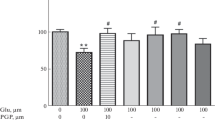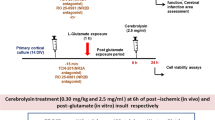Abstract
While the role of apoptosis in neuronal injury is continually being re-defined, approaches to intervene in the progression of apoptotic injury have been documented to provide neuroprotection against a variety of insults. The present studies were undertaken to systematically study the effects of certain neuroprotective agents against neuronal apoptosis mediated by staurosporine (ST). ST (0.01–5 μM) produced a dose-related apoptotic injury (as characterized by cellular morphology, ‘Comet’ assay analysis [single cell gel electrophoresis] and caspase-3 activation) in primary cultures of forebrain neurons. ST significantly increased caspase-3 activity. The NMDA receptor subtype non-selective antagonist dizocilpine [(+) MK-801; 0.1–50 μM) and a novel sodium channel blocker RS100642 (1.0–250 μM) had no significant effects against ST-induced neurotoxicity. Conversely, NR2B-selective NMDA receptor antagonists CGX-1007 (0.01–50 μM) and ifenprodil (0.01–50 μM) provided dose-dependent neuroprotection against ST-induced neurotoxicity (as measured by neuronal viability and comet assay analysis). CGX-1007 had no significant effect on ST-induced caspase-3 activity; however, ifenprodil did block activation of caspase-3. These studies demonstrate that NR2B NMDA receptor antagonists are anti-apoptotic and may mediate their action via mechanism(s) that are dependent or independent of caspase-3 activation.
Similar content being viewed by others
References
Ahlemeyer B, S Klumpp and J Krieglstein (2002) Release of cytochrome c into the extracellular space contributes to neuronal apoptosis induced by staurosporine.Brain Res. 934, 107–116.
Badolo L, J Dubois, M Helson-Cambier and M Hanocq (1998) Inhibition of orinithine decarboxylase by ifenprodil.Eur. J. Pharm. 342, R1-R2.
Bialer M, S Johannessen, H Kupferberg, R Levy, P Loiseau and E Perucca (2002) Progress report on new antiepileptic drugs: a summary of the Sixth Eilat Conference (EILAT VI). Epilepsy Res.51, 31–71.
Bredesen DE (1995) Neural apoptosis.Ann. Neurol. 38, 839–851.
Bresink I, TA Bentke, VJ Collett, AJ Seal, CG Parsons, JM Henley and GI Collingridge (1996) Effects of memantine on recombinant rat NMDA receptors expressed in HEK 293 cells.Brit. J. Pharmacol.,119, 195–204.
Budihardjo I, H Oliver, M Lutter, X Luo and X Wang (1999) Biochemical pathways of caspase activation during apoptosis.Annu. Rev. Cell Dev. Biol. 15, 269–290.
Chang SH, PC Phelps, IK Berezesky, MJ Ebersberger and BF Trump (2000) Studies on the mechanisms and kinetics of apoptosis induced by microinjection of cytochrome c in rat kidney tubule epithelial cells (NRK-52E).Am. J. Pathol. 156, 637–649.
Chazot PL and FA Stephenson (1997) Molecular dissection of native forebrain NMDA receptors containing the NR1 C2 exon: direct demonstration of NMDA receptors comprising NR1, NR2A and NR2B subunits within the same complex.J. Neurochem. 69, 2138–2144.
Chazot PL, SK Coleman, M Cik and FA Stephenson (1994) Molecular characterization of NMDA receptors expressed in mammalian cells yields evidence for the coexistence of three subunit types within a discrete receptor molecule.J. Biol. Chem. 269, 24403–24409.
Clark RS, J Chen, SC Watkins, PM Kochanek, M Chen, RA Stetler, JE Loeffert and SH Graham (1997) Apoptosis suppressor gene bcl-2 expression after traumatic brain injury in rats.J. Neurosci. 17, 9172–9182.
Cohen GM, XM Sun, RT Snowden, D Dinsdale and DN Skilleter (1992) Key morphological features of apoptosis may occur in the absence of internucleosomal DNA fragmentation.J. Biochem. 286, 331–334.
Contreras PC, ME Bremer and NM Gray (1990) Ifenprodil and SL 82.0715 potently inhibit binding of [3H](+)-3-PPP to sigma binding sites in rat brain.Neurosci. Lett. 116, 190–193.
Dave JR, ML Koenig, FC Tortella, RA Pieringer, BP Doctor and HS Ved (1997) Dodecylglycerol provides partial protection against glutamate toxicity in neuronal cultures derived from different regions of embryonic rat brain.Mol. Chem. Neuropathol. 30, 1–13.
Dave JR, Y Lin, M Koenig, HS Ved, L Clapp, JC Hunter and FC Tortella (2001) RS-100642-198, a novel sodium channel blocker, provides differential neuroprotection against hypoxia/hypoglycemia, veratridine or glutamate-mediated neurotoxicity in primary cultures of rat cerebellar neurons.Neurotoxicity Res. 3, 381–395.
DeCoster MA, ML Koenig, JC Hunter and FC Tortella (1992) Calcium dynamics in neurons treated with toxic and non-toxic concentrations of glutamate.Neuro Report 9, 773–776.
Dempsey RJ, ML Baskaya and A Dogan (200)) Attenuation of brain edema, blood-brain barrier breakdown, and injury volume by ifenprodil, a polyamine-siteN-methyl-D-aspartate receptor antagonist, after experimental traumatic brain injury in rats.Neurosurgery 47, 399–404.
Heshmukh M, C Du, X Wang and EM Johson (2002) Exogenous Smac induces competence and permits caspase activation in sympathetic neurons.J. Neurosci. 22, 8018–8027.
Dingledine R, K Borges, D Bowie and SF Traynelis (1999) The glutamate receptor ion channels.Pharmacol. Rev. 51, 7–62.
Dogan A, AM Rao, MK Baskaya, VL Rao, J Rastl, D Donaldson and RJ Dempsey (1997) Effects of ifenprodil, a polyamine site NMDA receptor antagonist, on reperfusion injury after transient focal cerebral ischemia.J. Neurosurg. 87, 921–926.
Donevan S and R McCabe (2000) Conantokin G is an NR2B-selective competitive antagonist ofN-methyl-d-aspartate receptors.Mol. Pharmacol. 58, 614–623.
Fischer G, V Mutel, G Trube, P Malherbe, JNC Kew, E Mohacsi MP Heitz and JA Kemp (1997) Ro-25-6981, a highly potent and selective blocker ofN-methyl-D-aspartate receptors containing the NR2B subunit. Characterizationin vitro.J. Pharm. Exp. Ther. 283, 1285–1292.
Gwag BJ, LM Canzoniero, SL Sensi, JA Demaro, JY Koh, MP Goldberg, M Jacquin and DW Choi (1999) Calcium ionophores can induce either apoptosis or necrosis in cultured cortical neurons.Neuroscience. 90, 1339–1348.
Hara H, RM Griedlander, V Gagliardini, C Ayata, K Fink, Z Huang, M Shimizu-Sasamata, J Yuan and MA Moskowitz (1997) Inhibition of interleukin 1 beta converting enzyme family proteases reduces ischemic and excitotoxic neuronal damage.Proc. Natl. Acad. Sci. USA 94, 2007–2012.
Hawkins LM, PL Chazot and FA Stephenson (1999) Biochemical evidence for the co-association of three NR2 subunits in recombinantN-methyl-D-aspartate receptors.J. Biol. Chem. 274, 27211–27218.
Hengartner MO (2000) The biochemistry of apoptosis.Nature 407, 770–776.
Isenmann S, G Stoll, M Schroeter, S Krajewski, JC Reed and M Bahr (1998) Differential regulation of Bax, Bcl-2, and Bcl-X proteins in focal cortical ischemia in the rats.Brain Pathol. 8, 49–62.
Juin P, AO Hueber, T Littlewood and G Evan (1999) c-Myc-induced sensitization to apoptosis is mediated through cytochrome c release.Genes Dev. 13, 1367–1381.
Kew J and J Kemp (1998) An allosteric interaction between NMDA receptor polyamine and ifenprodil sites in rat cultured cortical neurons.J. Physiol. 512, 17–28.
Khan AM, BG Stanley, L Bozzetti, C Chin, C Stivers and MC Curras-Collazo (2000)N-methyl-D-aspartate receptor subunit NR2B is widely expressed throughout the rat diencephalon: an immunohistochemical study.J. Comp. Neurobiol. 428, 428–449.
Koh J, M Wie, B Gwag, S Sensi, L Canzoniero, J Demaro, C Csemansky and D Choi (1995) Staurosporine-induced neuronal apoptosis.Exp. Neurol. 135, 153–159.
Kruidering M, T Schouten, GI Evan and E Vreugdenhi (2001) Caspase-mediated cleavage of the Ca2+/calmodulin-dependent protein kinase-like kinase facilitates neuronal apoptosis.J. Biol. Chem. 276, 38417–38425.
Li P, D Nijhawan, I Budihardjo, SM Srinivasula, M Ahmad, ES Alnemri and X Wang (1997) Cytochrome c and dATP-dependent formation of Apaf-1/caspase-9 complex initiates an apoptotic protease cascade.Cell 91, 479–489.
Li Y, M Chopp, C Powers and N Jiang (1997) Apoptosis and protein expression after focal cerebral ischemia in rat.Brain Res. 765, 301–312.
Luo X, I Budihardjo, H Zou, C Slaughter and X Wang (1998) Bid, a Bcl 2 interacting protein, mediates cytochrome c release from mitochondria in response to activation of cell surface death receptors.Cell 94, 481–490.
Menniti F, B Chenard, M Collins, M Ducat, I Shalaby and F White (1997) CP-101, 606, a potent neuroprotectant selective for forebrain neurons.Eur. J. Pharmacol. 331, 117–126.
Monyer H, R Sprengel, R Schoepfer, A Herb, M Higuchi, H Lomeli, N Burnashev, B Sakmann and PH Seeburg (1992) Heteromeric NMDA receptors: molecular and functional distinction of subtypes.Science 256, 1217–1221.
Monyer H, N Burnashev, DJ Laurie, B Sakmann and PH Seeburg (1994) Developmental and regional expression in the rat brain and functional properties of four NMDA receptors.Neuron 12, 529–540.
Portera-Cailliau C, DL Price and LJ Martin (1997) Non-NMDA and NMDA receptor-mediated excitotoxic neuronal deaths in adult brain are morphologically distinct: further evidence for an apoptosis-necrosis continuum.J. Comp. Neurol.,378, 88–104.
Prorok M and F Castellino (2001) Structure-function relationships of the NMDA receptor antagonist conantokin peptides.Curr. Drug Targets 2, 313–322.
Skolnick P, K Boje, R Miller, M Pennington and M Maccecchini (1992) Noncompetitive inhibition ofN-methyl-D-aspartate by conantokin-G: evidence for an allosteric interaction at polyamine sites.J. Neurochem. 59, 1516–1521.
Sloviter RS, E Dean, AL Sollas and JH Goodman (1996) Apoptosis and necrosis induced in different hippocampal neuron populations by repetitive perforant path stimulation in the rat.J. Comp. Neurol 366, 516–533.
Steinberg G, N Panahian, M Perez-Pinzon, G Sun, M Modi and J Sepinwall (1995) Narrow temporal therapeutic window for NMDA antagonist protection against focal cerebral ischemia.Neurobiol. Dis. 2, 109–118.
Tamoki T (1986) Staurosporine a potent inhibitor of phospholipid/Ca++ dependent protein kinase.Biochem. Biophys. Res. Commun. 135, 397–403.
Thompson CL, DL Drewery, HD Atkins, FA Stephenson and PL Chazot (2000) Immunohistochemical localization ofN-methyl-D-aspartate receptor NR1, NR2A, NR2B and NR2C/D subunits in the adult mammalian cerebellum.Neurosci. Lett. 283, 85–88.
Tomei LD, JP Shapiro and FO Cope (1993) Apoptosis in C3H/10T 1/2 mouse embryonic cells: evidence for internucleosomal DNA modification in the absence of double-strand cleavage.Proc. Natl. Acad. Sci. USA 90, 853–857.
Ved HS, E Gustow and RA Pieringer (1991) Regulation of neuronal differentiation in enriched primary cultures from embryonic rat cerebra by platelet activating factor and the structurally related glycerol ether lipid, dodecylglycerol.J. Neurosci. Res. 30, 353–358.
Wenzel A, L Scheurer, R Kunzi, JM Fritschy, H Mohler and D Benke (1995) Distribution of NMDA receptor subunit proteins NR2A, 2B, 2C and 2D in rat brain.NeuroReport 7, 45–48.
Williams AJ, JR Dave, J Phillips, Y Lin, R McCabe and FC Tortella (2000) Neuroprotective efficacy and therapeutic window of the high-affinityN-methyl-D-aspartate antagonist conantokin-G:in vitro (primary cerebellar neurons) andin vivo (rat model of transient focal brain ischemia) studies.J. Phamacol. Exp. Ther. 294, 378–386.
Williams AJ, JR Dave, XM Lu, G Ling and FC Tortella (2002) Selective NR2B NMDA receptor antagonists are protective against staurosporine-induced apoptosis.Eur. J. Pharmacol. 452, 135–136.
Williams K (1993) Ifenprodil discriminates subtypes of theN-methyl-D-aspartate receptors: selectivity and mechanism at recombinant heteromeric receptors.Mol. Pharmacol. 44, 851–859.
Zhou L, G Szendrei, L Fossom, M Maccecchini, P Skolnick and L Otvos (1996) Synthetic analogues of conantokin-G: NMDA antagonists acting through a novel polyamine-coupled site.J. Neurochem. 66, 620–628.
Zhu Y, G-Y Yang, B Ahlemeyer, L Pang, X-M Che, C Culmsee, S Klupp and J Krieglstein (2002) Transforming growth factor-β1 increases Bad phosphorylation and protects neurons against damage.J. Neurosci.,22, 3898–3909.
Author information
Authors and Affiliations
Corresponding author
Rights and permissions
About this article
Cite this article
Dave, J.R., Williams, A.J., Moffett, J.R. et al. Studies on neuronal apoptoisis in primary forebrain cultures: Neuroprotective/anti-apoptotic action of NR2B NMDA antagonists. neurotox res 5, 255–264 (2003). https://doi.org/10.1007/BF03033383
Received:
Revised:
Accepted:
Issue Date:
DOI: https://doi.org/10.1007/BF03033383




